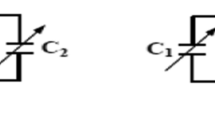Abstract
A novel current-mode Winner-Take-All (WTA) topology is presented in this paper. The dynamic response of the circuit is improved by lowering the voltage swing required at the input nodes to turn on the winning cell. The WTA was designed and fabricated in 0.13 \(\upmu \)m CMOS technology with 2.5 V single supply voltage. Experimental results show an at least 26 % reduction in response time, as well as a reduction in the maximum output current error, when compared to other widely used current-mode topologies, with comparable bandwidth, area, and power consumption. The area of the proposed circuit is 47 \(\times \) 41 \(\upmu \mathrm{m}^{2}\) and it consumes 87 \(\upmu \)W per unit cell. The measured maximum output current error was 4.8 \(\upmu \)A, and a resolution of 1.85 \(\upmu \)A was obtained. The capability of the WTA to rectify signals was also experimentally demonstrated.











Similar content being viewed by others
References
S. Badel, A. Schmid, Y. Leblebici, CMOS realization of two-dimensional mixed analog-digital Hamming distance discriminator circuits for real-time imaging applications. Microelectron. J. 39(12), 1817–1828 (2008)
K.L. Baishnab, M. Rahaman, F.A Talukdar, in A 200\(\mu \)V resolution and high speed VLSI Winner-take-all circuit for self-organising neural network. Proceedings of the International Conference on Methods and Models in Computer Science New Delhi, India, December 2009, pp. 1–4
M. Bigas, E. Cabruja, J. Forest, J. Salvi, Review of CMOS image sensors. Microelectron. J. 37(5), 433–451 (2006)
S. Brink, S. Nease, P. Hasler, S. Ramakrishnan, R. Wunderlich, A. Basu, B. Degnan, A learning-enabled neuron array IC based upon transistor channel models of biological phenomena. IEEE Trans. Biomed. Circ. Syst. 7(1), 71–81 (2013)
R.G. Carvajal, J. Ramírez-Angulo, J. Martínez-Heredia, High-speed high-precision min/max circuits in CMOS technology. Electron. Lett. 36(8), 697–699 (2000)
A. Fish, V. Milrud, O. Yadid-Pecht, High-speed and high-precision current Winner-Take-All circuit. IEEE Trans. Circ. Syst. II 52(3), 131–135 (2005)
J.G.R.C. Gomes, A. Petraglia, S.K. Mitra, Sensitivity analysis of multilayer perceptrons applied to focal-plane image compression. IET Circ. Devices Syst. 1(1), 79–86 (2007)
G. Indiveri, in Neuromorphic selective attention systems, Proceedings of the International Symposium on Circuits and Systems, Bangkok, Thailand, vol. III, May 2003, pp. 770–773.
G. Indiveri, A current-mode hysteretic Winner-Take-All network, with excitatory and inhibitory coupling. Analog Integr. Circ. Signal Process. 28(3), 279–291 (2001)
R. Izak, G. Scarbata, P. Paschke, in Sound source localization with an Integrate-and-Fire neural system, Proceedinhs of the 7th International Conference on Microelectronics for Neural, Fuzzy and Bio-Inspired Systems, Granada, Spain, April 1999, pp. 103–109.
J. Koton, A. Lahiri, N. Herencsar, K. Vrba, in Current-mode precision full-wave rectifier using two WTA cells, Proceedings of the 34th International Conference on Telecommunications and Signal Processing, Budapest, Hungary, August 2011, pp. 324–327.
J. Koton, A. Lahiri, N. Herencsar, K. Vrba, Current-mode dual-phase precision full-wave rectifier using current-mode two-cell Winner-Takes-All (WTA) circuit. Radioengineering 20(2), 428–432 (2011)
J. Lazzaro, S. Ryckebusch, M.A. Mahowald, C.A. Mead, in Winner-Take-All networks of O(n) Complexity, vol. 1, ed. by D.S Touretzky. Advances in neural information processing systems (Morgan Kaufmann, San Mateo, CA, 1989), pp. 703–711.
N. Massari, M. Gottardi, Low power WTA circuit for optical position detector. Electron. Lett. 42(24), 1373–1374 (2006)
P. Prommee, K. Chattrakun, CMOS WTA maximum and minimum circuits with their applications to analog switch and rectifiers. Microelectron. J. 42(1), 52–62 (2011)
J. Ramírez-Angulo, J.E. Molinar-Solis, S. Gupta, R.G. Carvajal, A.J. López-Martín, A high-swing, high-speed CMOS WTA using differential flipped voltage followers. IEEE Trans. Circ. Syst. 54(8), 668–672 (2007)
B. Sekerkiran, U. Cilingiroglu, in Improving the resolution of Lazzaro winner-take-all circuit. Proceedings of the International Conference on Neural Networks, vol. 2, Houston, June 1997, pp. 1005–1008.
O. Sgrott, D. Mosconi, M. Perenzoni, G. Pedretti, L. Gonzo, D. Stoppa, A 134-pixel CMOS sensor for combined time-of-flight and optical triangulation 3-D imaging. IEEE J. Solid-State Circ. 45(7), 1354–1364 (2010)
Acknowledgments
This work was supported by CONACyT 227989 Doctoral Grant and CONACyT CB-SEP-2008-01-99901 Research Project.
Author information
Authors and Affiliations
Corresponding author
Rights and permissions
About this article
Cite this article
Moro-Frias, D., Ventura-Arizmendi, C., Sanz-Pascual, MT. et al. Current-Mode Winner-Take-All Circuit with Improved Dynamic Response. Circuits Syst Signal Process 34, 625–639 (2015). https://doi.org/10.1007/s00034-014-9865-7
Received:
Revised:
Accepted:
Published:
Issue Date:
DOI: https://doi.org/10.1007/s00034-014-9865-7




